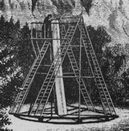History:
- “Having completed and extended his father’s catalogue of the northern heavens, John Herschel arrived at the Cape, in January 1834 (ten days after Maclear) with the set intention of making a similar catalogue for the Southern Hemisphere. He bought an estate at Feldhausen, six miles from Gape Town, erected his 20-ft. focus reflector and a 7-ft. refractor and was ready for work before June.” [Copied from Moore, p. 51]
- “Herschel described his house and estate at Feldhausen as occupying “one of the most magnificent sites I ever saw”. The site is breath-taking even today; and a visit to the Herschel Obelisk – about which more will be said later – is well worth while. The monument stands on the exact spot where the 20-ft. reflector was set up, just to the east of the Table Mountain massif. From this viewpoint Devil’s Peak looms majestically in the distance, a circumstance which, for all its beauty, was to prove somewhat of a nuisance in Herschel’s cometary observations.
The homestead itself was demolished as recently as 1958, but from contemporary pictures and descriptions, an excellent idea of it may be conjured up. It was built in the Cape Dutch style with a thatched roof, a central gable, and a wide stoep with seats at either end. Entrance to the house was gained by a flight of broad steps, flanked by enormous oaks. The walls, built of cut river-stone and sun-baked brick, were two feet thick, providing warmth in winter and coolness in summer. Heavy stink wood joists supported the floors, and yellow wood doors with hand wrought iron hinges added to the general charm. The floor of the spacious entrance hall was of grey Batavian flagstones.
The outbuildings included servants’ quarters, stables, a cowshed, and a circular dairy. A cottage in the grounds was pressed into service as Sir John’s workshop, where he polished his mirrors, conducted chemical experiments, and spent hours in his studies of the coloration of flowers. Two hexagonal sentry-boxes were situated at strategic points One of these exists today, the sole forlorn survivor of all the gracious buildings which Sir John and Lady Herschel knew. An impressive stone-pine avenue led eastward, and a cross-avenue of oaks stretched to the edge of the vineyard. The estate was of 99 morgen, a goodly size even in those days”. [Copied from Moore, pp. .52 – 55]
- “For reasons which remain something of a mystery – after all, his home was six thousand miles away – Herschel bought the estate in 1835 for the sum of £3 000. Laudable attempts have been made to estimate how much this figure would represent in modern currency, but in these days of rocketing land values the calculation depends on so many imponderable values that it is almost impossible to make. It is only necessary to add that a 10 Ib. fish could be bought for 2d, while butcher’s meat was Ir d per Ib.! Fortunately, Herschel’s parents had left him well off. When he returned to England, the Government offered to reimburse him for the money he had spent on his South Africa expedition. Herschel refused.” [Copied from Moore, p. 55.]
|
Remaining Artifacts:
- Herschel Obelisk
- Feldhausen Avenue, Wynberg.
Pictorial Sources:
- Africana Museum [Moore, pp. 52 – 53]
Bibliography:
- Moore, P. & Collins, P., Astronomy in Southern Africa, p. 15, pp. 51 – 55, pp. 64 – 66 (General Source)
|

